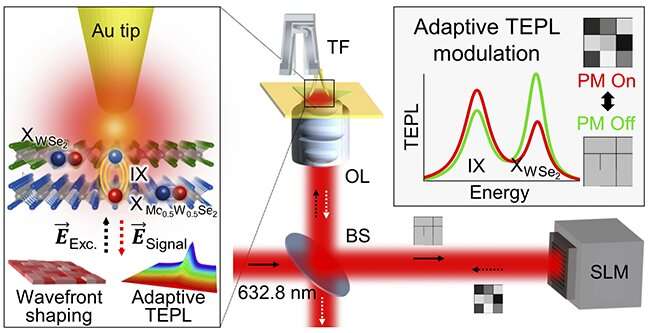This article has been reviewed according to Science X's editorial process and policies. Editors have highlighted the following attributes while ensuring the content's credibility:
fact-checked
peer-reviewed publication
trusted source
proofread
Team develops the world's smallest and fastest nano-excitonic transistor

How can Marvel movie character Ant-Man produce such strong energy out of his small body? The secret lies in the transistors on his suit that amplify weak signals for processing. Transistors that amplify electrical signals in the conventional way lose heat energy and limit the speed of signal transfer, which degrades performance. What if it were possible to overcome such limitations and make a high-performance suit that is light and small but without the loss of heat energy?
A POSTECH team of Professor Kyoung-Duck Park and Yeonjeong Koo from the Department of Physics and a team from ITMO University in Russia led by Professor Vasily Kravtsov jointly developed a nano-excitonic transistor using intralayer and interlayer excitons in heterostructure-based semiconductors, which addresses the limitations of existing transistors. The research was recently published in the journal ACS Nano.
Excitons are responsible for light emission of semiconductor materials and are key to developing a next-generation light-emitting element with less heat generation and a light source for quantum information technology due to the free conversion between light and material in their electrically neutral states.
There are two types of excitons in a semiconductor heterobilayer, which is a stack of two different semiconductor monolayers: the intralayer excitons with horizontal direction and the interlayer excitons with vertical direction.
Optical signals emitted by the two excitons have different lights, durations, and coherence times. This means that selective control of the two optical signals could enable the development of a two-bit exciton transistor. However, it was challenging to control intra- and interlayer excitons in nano-scale spaces due to the non-homogeneity of semiconductor heterostructures and low luminous efficiency of interlayer excitons in addition to the diffraction limit of light.
The team in its previous research had proposed technology for controlling excitons in nano-level spaces by pressing semiconductor materials with a nano-scale tip. This time, for the first time ever, the researchers were able to remotely control the density and luminance efficiency of excitons based on polarized light on the tip without directly touching the excitons. The most significant advantage of this method, which combines a photonic nanocavity and a spatial light modulator, is that it can reversibly control excitons, minimizing physical damage to the semiconductor material. Also, a nano-excitonic transistor that uses light can help process massive amounts of data at the speed of light while minimizing heat energy loss.
Artificial intelligence (AI) has made inroads into our lives more quickly than we ever expected, and it requires huge volumes of data in order to provide good answers that are actually helpful for users. The ever-increasing volume of information should be collected and processed as more and more fields utilize AI. This research is expected to propose a new data processing strategy befitting an era of data explosion. Yeonjeong Koo, one of the co-first authors of the research paper, said, "The nano-excitonic transistor is expected to play an integral role in realizing an optical computer, which will help process the huge amounts of data driven by AI technology."
More information: Yeonjeong Koo et al, Nanocavity-Integrated van der Waals Heterobilayers for Nano-excitonic Transistor, ACS Nano (2023). DOI: 10.1021/acsnano.2c11509
Journal information: ACS Nano
Provided by Pohang University of Science and Technology





















